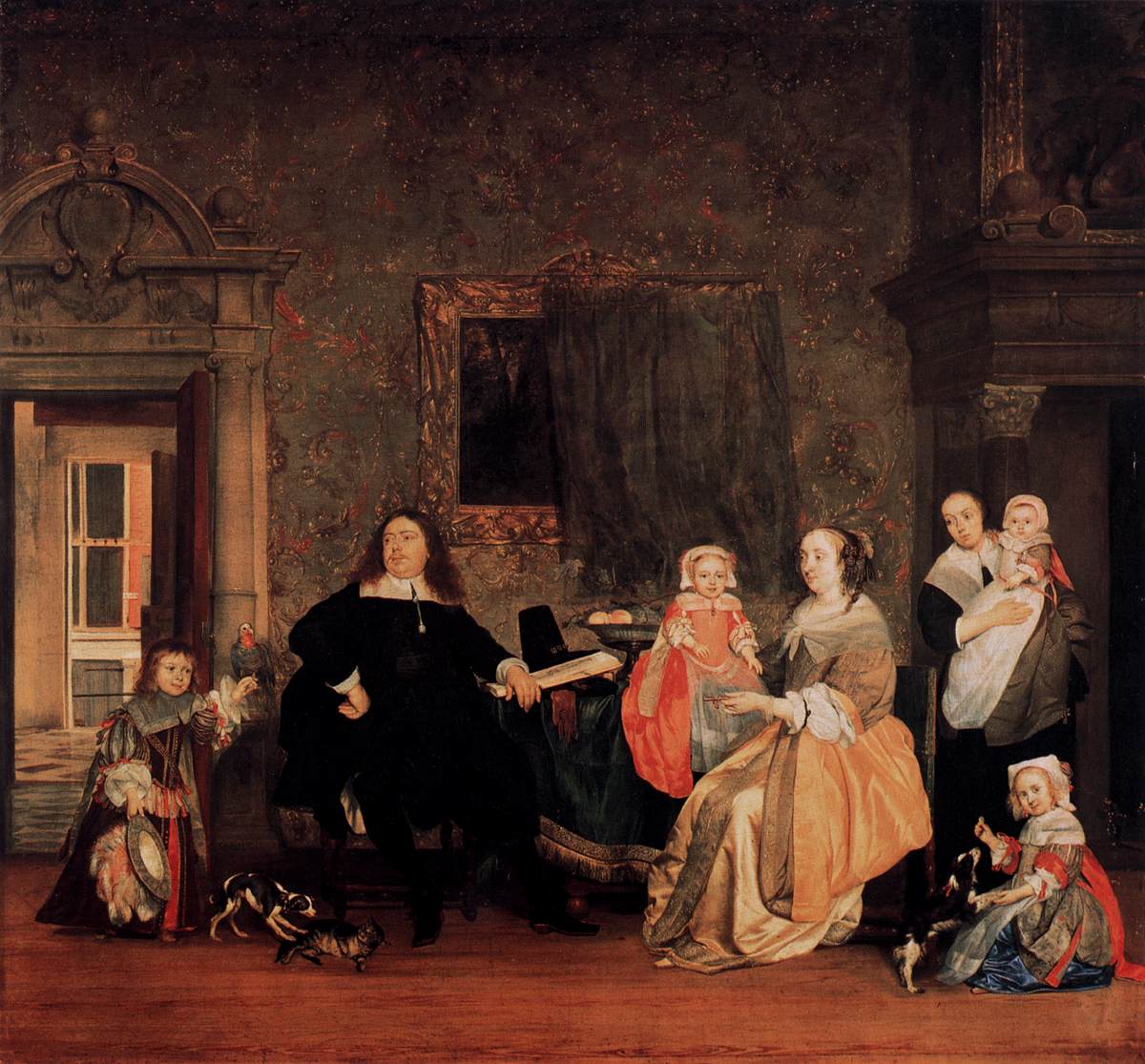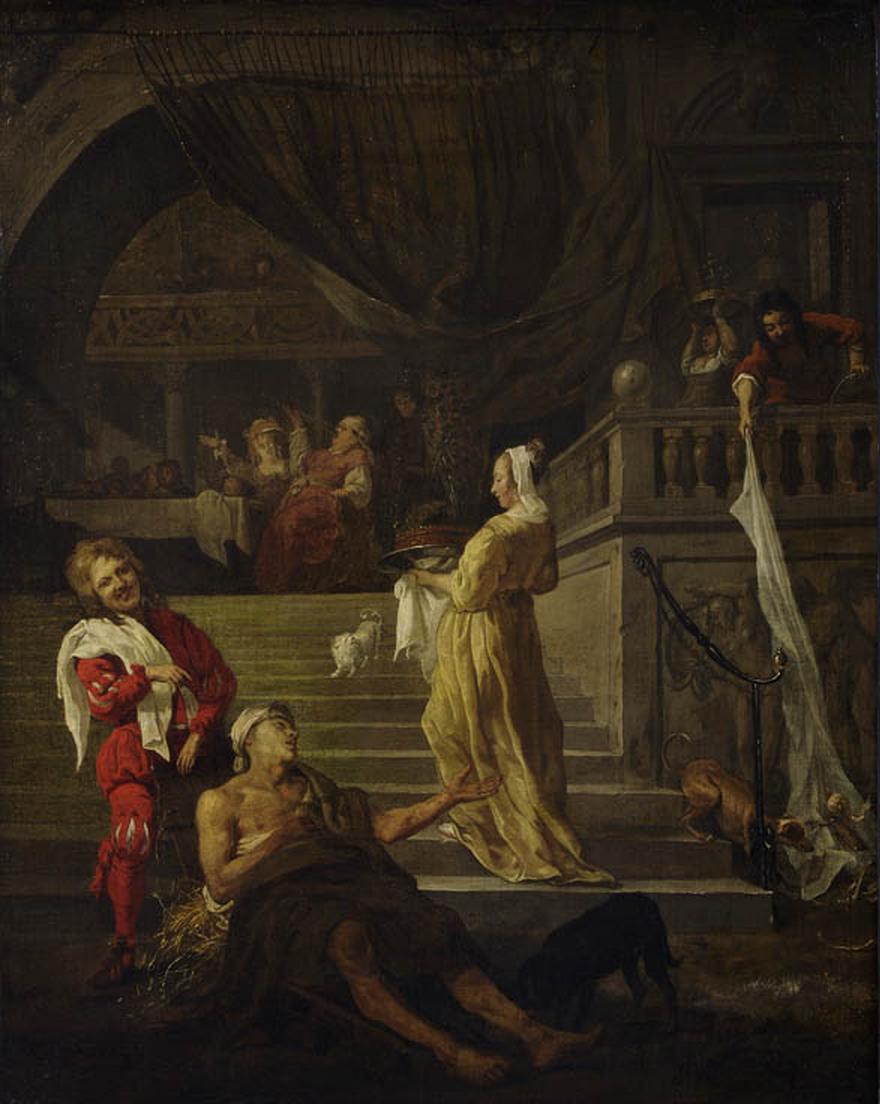An exhibition of some 40 of the finest and most celebrated
masterpieces by the Dutch 17th-century artist Gabriel Metsu (1629-1667) was
presented in the National Gallery of Ireland 4 September - 5 December 2010. It was organised by the National Gallery of Ireland, Dublin, in
association with the Rijksmuseum, Amsterdam, and the National Gallery of Art,
Washington.
The exhibition, Gabriel Metsu: Rediscovered Master of the
Dutch Golden Age featured works from all phases of the artist's career,
including a number of recently discovered and restored works. It paid homage to
his engaging genre scenes which vary from musical companies and amorous
encounters, to revellers, street traders and kitchen maids. Examples of Metsu's
lesser known yet wonderfully accomplished achievements in the fields of
religious painting, portraiture and still life are also highlighted. The works
in the exhibition were drawn from public and private collections around the
world.
Born in Leiden in 1629, Metsu was, like his contemporary
Johannes Vermeer, one of the most important painters of his age. Despite his
untimely death at the age of 37, Metsu produced an outstanding oeuvre which
provides a fascinating glimpse into love, life and fashion in 17th-century
Holland. His remarkable mastery of the brush and talent for imbuing his figures
with humanity and personality drew admiration from both artists and collectors
of his time. This exhibition is an opportunity to re-evaluate an artist who was
one of the most collectable artists of the 17th and 18th centuries.
Among the works in the exhibition were a number of recently
discovered paintings that will afford a contemporary audience an opportunity to
evaluate the artist afresh, including
A Woman Artist (Le Corset rouge), (c.1661-4, Private Collection)
which features Metsu's wife, Isabella de Wolff, who frequently modelled for her husband.
The exhibition also reunited for the first time since the 18th century, two paintings which hung in the house of his most important patron, Jan Jacobsz.
Hinlopen: A Visit to the Nursery (1661, The Metropolitan Museum of Art, New York)
and A Portrait of Jan Jacobsz. Hinlopen and his Family (c.1662-3, Staatliche Museen zu Berlin).
A Woman Artist (Le Corset rouge), (c.1661-4, Private Collection)
which features Metsu's wife, Isabella de Wolff, who frequently modelled for her husband.
The exhibition also reunited for the first time since the 18th century, two paintings which hung in the house of his most important patron, Jan Jacobsz.
Hinlopen: A Visit to the Nursery (1661, The Metropolitan Museum of Art, New York)
and A Portrait of Jan Jacobsz. Hinlopen and his Family (c.1662-3, Staatliche Museen zu Berlin).
Like Vermeer, Metsu began his career as a history painter.
One of his earliest surviving biblical paintings,
Dives and Lazarus (c.1650, Musée des Beaux-Arts, Strasbourg)
was included here alongside
The Dismissal of Hagar (c.1653-4, Stedelijk Museum De Lakenhal, Leiden),
one of the highlights of Metsu's early career in Leiden.
Dives and Lazarus (c.1650, Musée des Beaux-Arts, Strasbourg)
was included here alongside
The Dismissal of Hagar (c.1653-4, Stedelijk Museum De Lakenhal, Leiden),
one of the highlights of Metsu's early career in Leiden.
The exhibition showed that Metsu was a versatile artist who
painted subjects ranging from interior scenes to portraiture. His favourite
subjects though were women attending to their daily chores, selling food, or
engaged in amorous pursuits:
A Young Woman Selling Poultry (1662, Staatliche Kunstsammlungen, Gemäldegalerie Alte Meister, Dresden);
A Woman Tuning her Cittern, Approached by a Man (c.1659-62, Museumslandschaft Hessen Kassel, Gemäldegalerie Alte Meister, Kassel).
A Young Woman Selling Poultry (1662, Staatliche Kunstsammlungen, Gemäldegalerie Alte Meister, Dresden);
A Woman Tuning her Cittern, Approached by a Man (c.1659-62, Museumslandschaft Hessen Kassel, Gemäldegalerie Alte Meister, Kassel).
Metsu painted himself at least ten times in various guises.
In one of the most accomplished of his blacksmith scenes,
A Cavalier Visiting a Blacksmith's Shop, (1654-6, The National Gallery, London),
Metsu portrays himself as the comically pompous cavalier who orders horse shoes from the smith.
In another painting,
A Hunter Getting Dressed after Bathing, (c.1654-6, Private Collection),
he depicted himself putting on his clothes after a swim in a brook.
A Cavalier Visiting a Blacksmith's Shop, (1654-6, The National Gallery, London),
Metsu portrays himself as the comically pompous cavalier who orders horse shoes from the smith.
In another painting,
A Hunter Getting Dressed after Bathing, (c.1654-6, Private Collection),
he depicted himself putting on his clothes after a swim in a brook.
In the early 1650s, Metsu moved to the larger and more
prosperous city of Amsterdam which had a profound effect on his career; he soon
transformed himself from a history painter into one of the leading painters of
'modern companies'.
His later works, painted in Amsterdam in the 1660s,
demonstrate the artist's technical virtuosity and also reflect the stylistic
influence of major genre painters of the time, most notably Gerrit Dou, Gerard
ter Borch, Frans Van Mieris and Johannes Vermeer.
Examples include
The Intruder (c.1661-3, National Gallery of Art, Washington) and

A Woman Composing Music, with an Inquisitive Man, (c.1664-7, Royal Picture Gallery Mauritshuis, The Hague).
Among the works which particularly recall Vermeer are the companion pieces,
A Man Writing a Letter
and A Woman Reading a Letter (c.1664-6, National Gallery of Ireland, Sir Alfred and Lady Beit Gift, 1987)
which are considered to be the artist's most renowned works. Another painting showing Vermeer's influence is
The Sick Child (1664-6, Rijksmuseum, Amsterdam),
one of the most iconic images of parental devotion in Dutch art. Towards the end of his life Metsu returned to painting religious subjects, the most dramatic of which is
Christ on the Cross (1664, Pinacoteca Capitolina, Rome).
Examples include
The Intruder (c.1661-3, National Gallery of Art, Washington) and

A Woman Composing Music, with an Inquisitive Man, (c.1664-7, Royal Picture Gallery Mauritshuis, The Hague).
Among the works which particularly recall Vermeer are the companion pieces,
A Man Writing a Letter
and A Woman Reading a Letter (c.1664-6, National Gallery of Ireland, Sir Alfred and Lady Beit Gift, 1987)
which are considered to be the artist's most renowned works. Another painting showing Vermeer's influence is
The Sick Child (1664-6, Rijksmuseum, Amsterdam),
one of the most iconic images of parental devotion in Dutch art. Towards the end of his life Metsu returned to painting religious subjects, the most dramatic of which is
Christ on the Cross (1664, Pinacoteca Capitolina, Rome).
Also on display were the only two drawings that are securely
attributed to Metsu: The Resurrection of Christ (c.1650-3, Musée Fabre,
Montpellier) and Sketch of a Female Figure (c.1662-4, Städel Museum, Frankfurt
am Main), which is a preparatory sketch for the painting, A Man Visiting a
Woman Washing her Hands (c. 1662-4, Private Collection).
The curator of the exhibition was Dr. Adriaan E. Waiboer
whose Ph.D. dissertation and forthcoming catalogue raisonné on Metsu provided
the knowledge base for the National Gallery exhibition. He is also editor of
the accompanying catalogue to the show which documents the social context in
which Metsu lived and worked. In his introductory essay, Dr. Adriaan Waiboer
gives an insight into the artist's life, work and reputation both during his
own lifetime and over the centuries. Another essay by his hand discusses
Metsu's relationship with Vermeer. He says:
"Metsu enjoyed admiration and success as an artist
during his lifetime. By the second half of the 18th century Metsu's pictures
could be found in some of the most prestigious collections in France, including
that of King Louis XV, while as many as 34 authentic works by Metsu were imported
into England, with Parisian auctions as their main origin. In recent years
however, Metsu has been somewhat eclipsed by the popularity of the Delft artist
Vermeer, which has prevented people from properly admiring or evaluating
Metsu's work. This exhibition hopes to rectify this and provide visitors with
the opportunity to explore and appreciate the full extent of the artist's
merits."
The exhibition catalogue includes six other informative
essays with contributions from Professor Wayne E. Franits (Syracuse
University): 'Gabriel Metsu and the Art of Luxury; Professor Linda
Stone-Ferrier (University of Kansas): 'Gabriel Metsu's Street Vendors-Shopping
for Values in the Dutch Neighbourhood'; E. Melanie Gifford (National Gallery of
Art, Washington): 'Fine Painting and Eloquent Imprecision: Metsu's Painting
Technique'; Pieter Roelofs (Rijksmuseum, Amsterdam): 'Early owners of Paintings
by Metsu in Leiden and Amsterdam'; Bianca M. du Mortier (Rijksmuseum,
Amsterdam): 'Costumes in Metsu's paintings: Mode and Manners in the
Mid-Seventeenth Century'; and Marijn Schapelhouman (Rijksmuseum, Amsterdam):
'Gabriel Metsu's Rare Drawings' (Rijksmuseum, Amsterdam).
The catalogue also reviews the contributions to literature
on the artist with particular reference to a number of published sources in the
18th and early 19th centuries which show that Metsu was highly respected in his
own life-time. Among the publications included in the display is a copy of John
Smith's Catalogue Raisonné of the Works of the Most Eminent Dutch, Flemish and
French Painters (vol. 4, London 1833) in which he argued that the 'superiority
of Metsu over every artist in the Dutch School is chiefly observable in the
chaste and beautiful drawing of his figures, accompanied by a peculiar
refinement of character, and where necessary, great elegance of manner'.
There was also material on loan from the archives in Leiden
and Amsterdam, including a number of notarial records. One of them documents a
visit by a certain Nicolaes De Roy to the young painter in Leiden around 1649.
De Roy ordered a portrait of himself from Metsu in return for a 'manikin' (a
wooden model). Records of sponsorship of young artists in 17th-century Holland,
such as this one, are rare. Also on loan is Jan Vos's Alle de Gedichten (All
his Poems) (vol.1, 1662 Library of the University of Amsterdam Special
Collections) which includes the poem originally commissioned from Jan Vos by
Hinlopen (Metsu's patron) on the virtues of the painting, A Visit to the
Nursery (1661, The Metropolitan Museum of Art, New York).
As part of the exhibition, the National Gallery of Ireland
had on display a number of interesting artefacts and objets d'art, many of
which feature in Metsu's paintings, such as an ornate Dutch picture frame
(c.1660-3, Natinoal Gallery of Ireland), which is identical to the one
appearing in the Gallery's painting, A Man Writing a Letter (1660-3). Also on
view is a goblet, made of buffalo horn in a silver mount (1566, Amsterdams
Historisch Museum), which belonged to the Amsterdam Guild of Saint Sebastian
and appears in A Woman Tuning her Citter, Approached by a Man (c.1659-62,
Museumslandschaft Hessen Kassel, Gemäldegalerie Alte Meister, Kassel). Other
objects include a so-called night-raile (c.1635, Fries Museum Leeuwarden) or
linen cloth, which was used to protect women's clothes while combing their
hair; a Standing Putto, by Johan Larson, after Francois Duquesnoy, which
features as a studio prop in Metsu's A Woman Artist (Le Corset rouge)
(c.1661-4, Private Collection); a sewing cushion in green velvet with an
interior of printed leather, similar to the one in Metsu's The Hunter's Gift
(c.1658-61, Rijksmuseum, Amsterdam); and a rare pair of embroidered Dutch mules
(c.1660) made of linen, hemp, silk and wool which appear in various paintings
in the exhibition,
The last major exhibition dedicated to Metsu was at the
Stedelijk Museum De Lakenhal in Leiden in 1966 and the most recent monograph
dedicated to his work was that written by Franklin W. Robinson and published in
1974. This exhibition is an opportunity to rediscover a wonderfully
accomplished artist whose works have gained him a place among the most
celebrated painters of 17th-century Holland.











